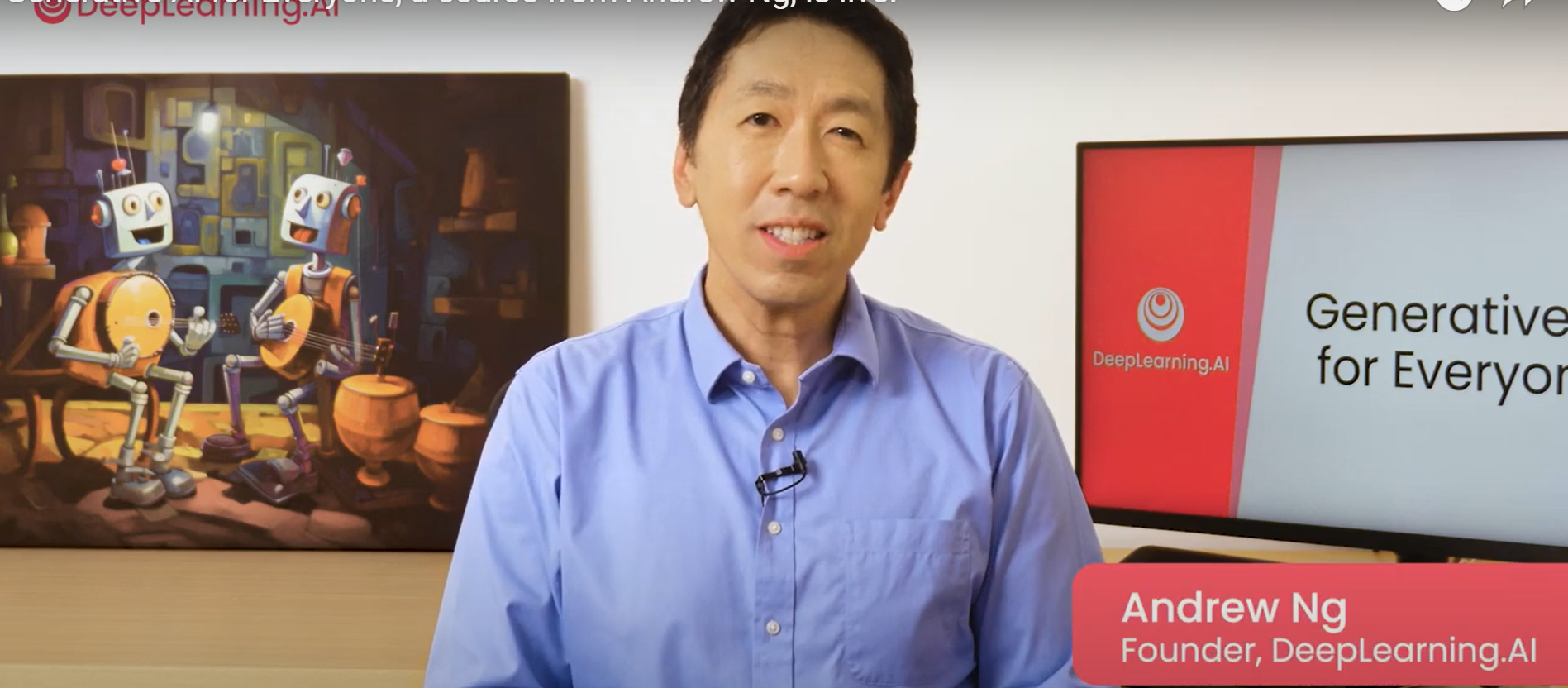As the least technically proficient member of a very tech-forward company, I definitely needed to get up to speed on Generative AI. So, like many, I took a course on Coursera, and I was lectured by the brilliant yet easily digestible Andrew Ng in “AI for Everyone,” a low-frills online course that’s served 1.6 million students and counting, making it Coursera’s fifth most popular course of all time. The class will be celebrating its fifth anniversary as a MOOC in a couple of months!
Ng, who is one of the founders of Coursera, helped popularize Artificial Intelligence as a broader concept, moving beyond the narrower ‘Machine Learning’ terminology that was common parlance when Dan was completing his degree in statistics (though Ng’s Machine Learning course on Coursera is even *more* popular). In robotics, Ng pioneered the paramount job of any human browsing the internet: cat recognition. I am convinced that was a turning point in our epistemology: Robots intake hundreds of thousands of cat images online → Now their minds can function in seemingly human ways. Take that, Iron Giant.
I highly recommend the course for anyone interested in how large language models (LLMs) operate in a very basic mathematical-logical sense. The course is also branded as very useful for folks who want to explore building tools and teams for the purposes of their jobs. Better than most teachers, Andrew Ng uses and reiterates concrete examples to really motivate students to keep learning–a providential counterpoint to his sedative voice.
Some of my favorite takeaways:
- The Goldilocks rule: AI can’t create utopia, and it can’t create dystopia. It is simply a powerful–but limited–tool whose harms can be mitigated.
- Artificial General Intelligence (AGI) Is Still Far Off: I am not sure Ng would still agree (and really, how updated the course is), but he emphasizes that it’s unlikely you’re meeting robots out there in the world that you wouldn’t be able to tell are robots–singularity isn’t exactly imminent.
- Building with Data: There’s plenty of free data out there online so that you can build your own AI projects! Vexingly, there is less now that US government statistical agencies are scaling down.
- LISTEN TO YOUR ENGINEERS: The ratio of learning that needs to happen for a company to make inroads with AI (executives, managers, and software engineers) 1:3:25. That said, you can start with what you have. Star engineers are made, not born.
- Leapfrogging potential: AI could very well be the next “third-world” leapfrogging phenomenon. Remember how compared to the Global South, the US was slow to adopt cell phones? They leapfrogged us! Ultimately, it’s because we already had reliable landlines. Knowledge management in places like Lima, Accra, or Colombo could really surprise us and move the world forward by framing work around AI in ways folks in London, Tokyo, and Seattle already have entrenched systems for.
- CBI, not UBI: Ever the consensus builder, Ng promotes not universal basic income, but conditional basic income, which the existence of AI can help set the stage for.
- AI should replace tasks, not jobs: AI should ultimately make society better off. This isn’t just our philosophy at AlignIQ, it’s straight from the mouth of the world’s foremost intellectual on the subject.
- The most AI-Proof job: Hairdresser (here’s one I recommend in Bethesda!)
- AI’s limits: There’s plenty that AI can’t do, and even more that it can’t do if your company doesn’t have data scientists or a unified data warehouse.
- AI’s limits, Part Deux: The first AI project that any company pilots will not and should not gain traction in less than 3 months. An AI project might seem neat-o in its nascence, but it needs lots of testing to be usefully embedded in a company’s SOPs.
- AI’s limits, Part Trey: AI is full of failures. Media and academics tend to publicize successes, so the survival bias lives on in our starry eyes.
- Low-Frills Learning, High-Impact Teaching: Totally random observation, but the most visually appealing aspect of the course is the weird AI-Generated robot art he has on the wall behind him. This only reinforces what I know as an educator to be true: PINTEREST CLASSROOMS ARE A RUSE FOR YOU BEING BORING, SALLY.
All in all, a great MOOC course. I’d say all the others I’ve taken (ah, COVIDtimes) have also been excellent, which speaks to the pedagogical accountability that sites like Coursera enable. This particular course charted my course toward engaging meaningfully with my colleagues at AlignIQ. We’re constantly building discourse around how AI can be applied in the workplace, and the focus group we just had this weekend really brought fresh ideas and use cases to add to our menu of services.
In a sense, I may be revealing and raving about a product that is essentially a competitor to ours, but I genuinely believe that we at AlignAI can take purpose-driven organizations much further with tailored strategies to catalyze their desired impacts in society. With this newfound understanding of AI’s capabilities and limits, I’m eager to help our clients harness, well, basically, robots who will create change where it matters most.
[In this post, we used AI for purpose, not polish.]
Resist Much, Obey Little! Read one of our other philosophical reflections here: https://aligniq.ai/ai-executes-humans-interpret-the-future-of-intelligence/
If you’d rather see how we play with AI storytelling tools, revisit How Uncanny Is My Valley?.
Ready to learn how AlignIQ can help you push past your beginner phase? https://aligniq.ai/governance-quickstart


Leave a Reply